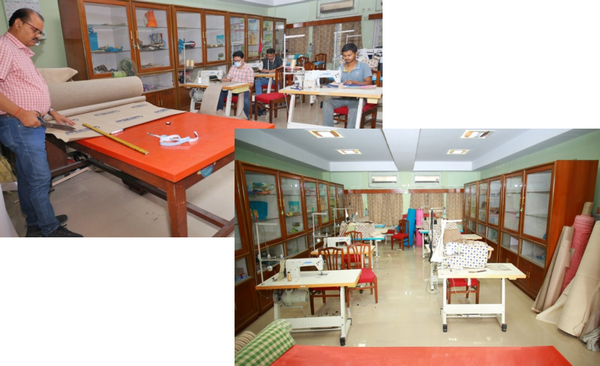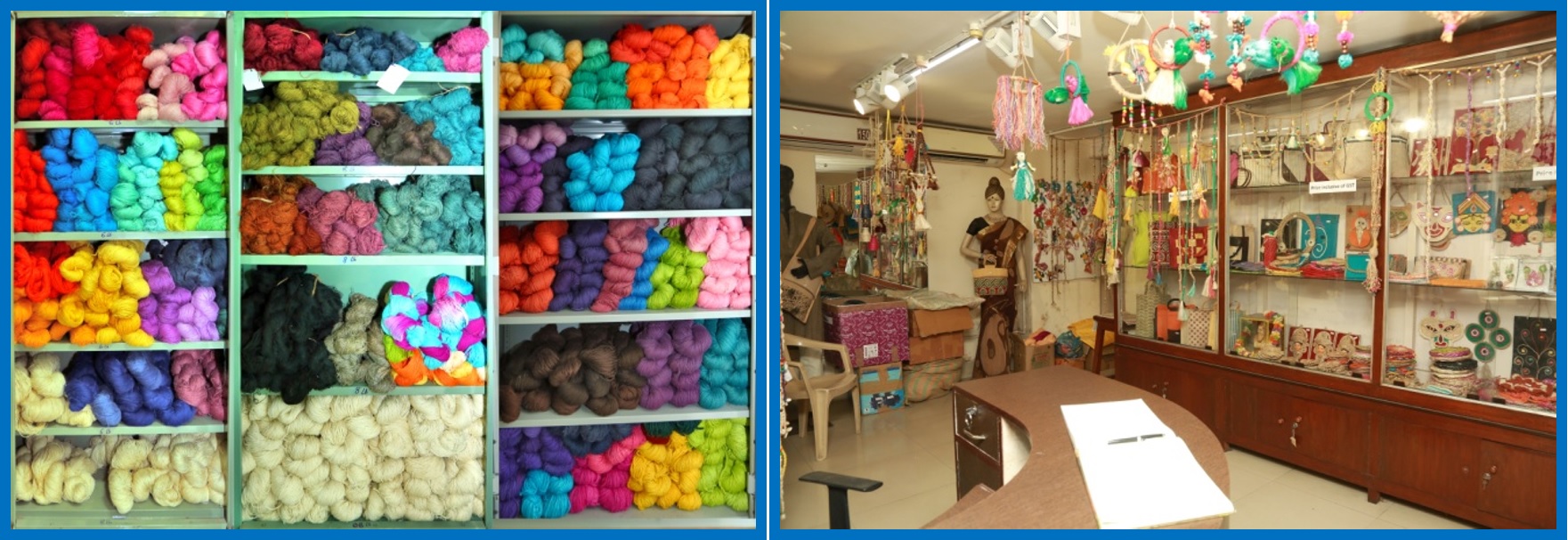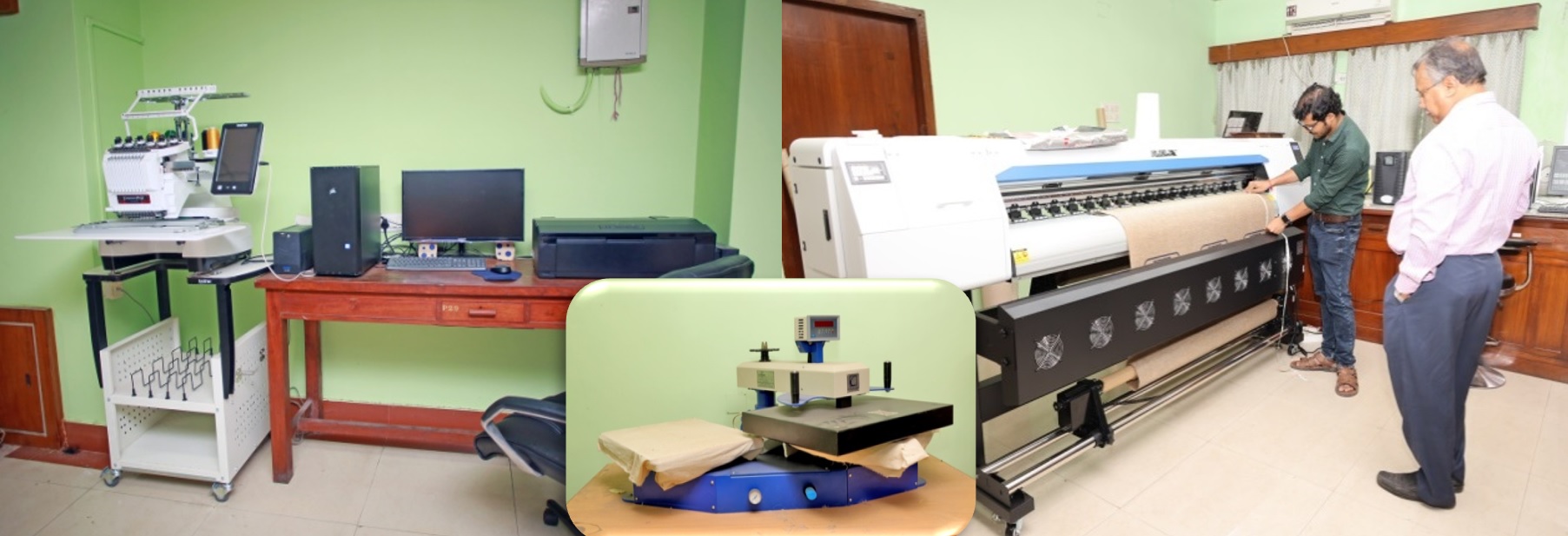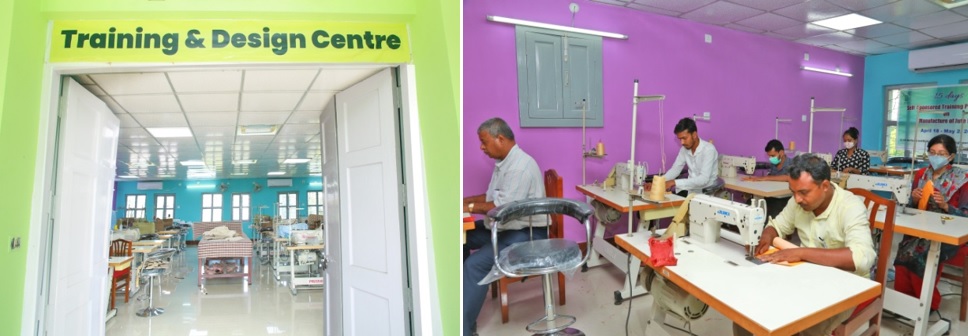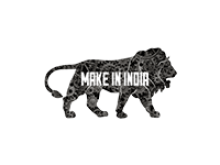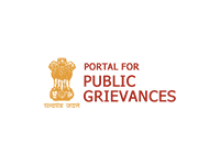
Facilities
Facilities
About the Laboratory
The Fibre Quality Testing Laboratory, accredited by NABL, specializes
in quality testing and grading jute and other natural fibers. Within its
facilities are mechanical grading instruments such as bundle strength testers
and airflow fineness meters, along with a Gravimetric fineness tester.
Additionally, the laboratory is equipped with BIS approved digital grading
instrument i.e., bundle strength testers, digital fineness
testers, and color and lustre meters, ensuring accurate, reliable, and
objective fiber analysis. Further, there are also multifibre testing
instruments. Through meticulous testing and precise measurements, the Fiber
Testing Laboratory upholds industry standards, facilitates innovation, and
fosters the development of high-quality fibers for a myriad of applications.
Mandate
·
Quality evaluation and grading of natural fibres
using instrumental method
·
Calibration of instate developed mechanical as
well as digital grading instruments
Nature of work
·
Conducting a range of tests to assess the quality,
strength, fineness, and other essential characteristics of fibers.
·
Grading of jute fibre as per BIS standard (IS: 271
(2020), IS: 7032(1986))
Instruments and Equipment available
|
Sl. |
Instrument/ Equipment |
Remarks |
|
1 |
Name of the instrument |
Mechanical bundle strength
tester |
|
2 |
Model |
NINFET-FBST-01 |
|
3 |
Test Parameters |
Bundle strength of fibre |
|
4 |
Sample Specification |
500 g |
|
|
|
|
Sl. |
Instrument/ Equipment |
Remarks |
|
1 |
Name of the instrument |
Air Flow Fineness tester |
|
2 |
Model |
NINFET-AFT-01 |
|
3 |
Test Parameters |
Fineness of fibre |
|
4 |
Sample Specification |
500 g |
|
|
|
|
Sl. |
Instrument/ Equipment |
Remarks |
|
1 |
Name of the instrument |
Gravimetric fineness
tester |
|
2 |
Model |
NINFET-TE-GFT-01 |
|
3 |
Test Parameters |
Fineness of fibre |
|
4 |
Sample Specification |
500 g |
|
|
|
|
Sl. |
Instrument/ Equipment |
Remarks |
|
1 |
Name of the instrument |
Automatic Electronic Bundle
strength tester |
|
2 |
Model |
NINFET-AFBST-MF-01 |
|
3 |
Test Parameters |
Fineness of fibre |
|
4 |
Sample Specification |
500 g |
|
|
|
|
Sl. |
Instrument/ Equipment |
Remarks |
|
1 |
Name of the instrument |
Digital fineness
tester |
|
2 |
Model |
NINFET-DFM-MF-01 |
|
3 |
Test Parameters |
Fineness of fibre |
|
4 |
Sample Specification |
500 g |
|
|
|
|
Sl. |
Instrument/ Equipment |
Remarks |
|
1 |
Name of the instrument |
Digital Colour and Lustre
meter |
|
2 |
Model |
NINFET-DCLM-MF-01 |
|
3 |
Test Parameters |
Colour and lustre of fibre |
|
4 |
Sample Specification |
20 reeds of fibre |
|
|
|
Contact Person
Dr. Avijit Das
Head, QE&I Division
ICAR-NINFET, Kolkata
Email: avijitcrri@gmail.com
About
the Laboratory
This
division have the facilities of
1.
Pulp and
Paper Laboratory.
2.
Bleaching
and Dyeing laboratory.
3.
Paper and
Bio Composite Testing Laboratory.
4.
Pilot Plant
for making Pulp-Paper & Particle Board.
5.
Pilot Plant
for Bleaching and Dyeing of yarn and fabric.
Chemical and Bio-chemical Laboratory
contains instrument for the testing of paper, particle board, dyed fabric/ yarn,
composite by the advance instruments like - Instron, Xenotest, Tensile Strength
tester, Folding Endurance, Crease Recovery etc.
Mandate
§ To improve the quantity of product from
jute and allied fibres by advanced chemical processing techniques like
bleaching, dyeing, printing & finishing.
§ To identity & develop diversified
product like handmade paper, composites, particle boards from jute & allied
fibre residues.
§ To impart skill development programs on
processing of jute & allied fibers and by- products utilisation.
Nature
of Work
§ Scouring, Bleaching & Dyeing of
yarn and fabric.
§ Bleaching of different Ligno-Cellulosic
pulp.
§ Preparation of pulp and paper from
different Ligno-Cellulosic pulp.
§ Preparation of different Hand Made
paper product, i.e. file, folder, jewellery box etc.
§ Preparation of particle board from
different natural resources.
§ Preparation of composite material.
Instrument
and Equipment available:
|
Sl. |
Instrument / Equipment |
Remarks |
|
1. |
Name of the instrument |
GSM measuring apparatus. |
|
2. |
Model |
UE POONA-4 |
|
3. |
Test parameters |
GSM |
|
4. |
Sample Specification |
10 cm X 10 cm |
|
|
|
|
|
Sl. |
Instrument
/ Equipment |
Remarks |
|
1. |
Name of the instrument |
TENSILE STRENGTH tester for
paper |
|
2. |
Model |
UEC-1005 D |
|
3. |
Test parameters |
Tensile Strength |
|
4. |
Sample Specification |
15mm x 150 mm |
|
|
|
|
|
Sl. |
Instrument / Equipment |
Remarks |
|
1. |
Name of the instrument |
Folding Endurance tester for
paper |
|
2. |
Model |
Uec-1007 B |
|
3. |
Test parameters |
Folding Strength |
|
4. |
Sample Specification |
15mm X 50 mm |
|
|
|
|
|
Sl. |
Instrument / Equipment |
Remarks |
|
1. |
Name of the instrument |
Bursting Strength tester for
paper |
|
2. |
Model |
UEC -1010 D |
|
3. |
Test parameters |
Bursting Strength |
|
4. |
Sample Specification |
10cm X 10 cm |
|
|
|
|
|
Sl. |
Instrument / Equipment |
Remarks |
|
1. |
Name of the instrument |
Tearing Strength tester for
paper |
|
2. |
Model |
TYPE B |
|
3. |
Test parameters |
Tearing Strength |
|
4. |
Sample Specification |
70mm X 50 mm, 04 No. samples
required for each testing |
|
|
|
|
|
Sl. |
Instrument / Equipment |
Remarks |
|
1. |
Name of the instrument |
INSTRON |
|
2. |
Model |
5967 |
|
3. |
Test parameters |
Testing of Composites
(Tensile / Flexural/ ILSS) |
|
4. |
Sample Specification |
30cm X 30 cm 05No. samples required for
each testing |
|
|
|
|
|
Sl. |
Instrument / Equipment |
Remarks |
|
1. |
Name of the instrument |
INSTRON |
|
2. |
Model |
5967 |
|
3. |
Test parameters |
TESTING OF Particle Board (Tensile
/ Flexural/ ILSS) |
|
4. |
Sample Specification |
30cm X 30 cm, 05No. samples required for
each testing |
|
|
|
|
|
Sl. |
Instrument / Equipment |
Remarks |
|
1. |
Name of the instrument |
CREASE RECOVERY |
|
2. |
Model |
IS 4681 |
|
3. |
Test parameters |
Crease recovery of fabric |
|
4. |
Sample Specification |
5 m2 |
|
|
|
|
|
Sl. |
Instrument / Equipment |
Remarks |
|
1. |
Name of the instrument |
FABRIC STIFFNESS |
|
2. |
Model |
ASTM D 1388 |
|
3. |
Test parameters |
Bending Length |
|
4. |
Sample Specification |
2 m2 |
|
|
|
|
|
Sl. |
Instrument / Equipment |
Remarks |
|
1. |
Name of the instrument |
XENOTEST |
|
2. |
Model |
ISO 105 B-02 |
|
3. |
Test parameters |
Light Fastness Testing |
|
4. |
Sample Specification |
30 X 30 cm |
|
|
|
|
Contact
person:
Dr. D. P. RAY,
Head of Department
Chemical and Bio-Chemical Division
E-mail: debprasad.ray@icar.gov.in
About the Laboratory
The Yarn
and Fabric Quality Testing Laboratory, accredited by NABL, specializes in
quality testing and grading jute and other natural fibers. Within its
facilities are mechanical grading instruments such as bundle strength testers
and airflow fineness meters, along with a Gravimetric fineness tester.
Additionally, the laboratory is equipped with BIS approved digital grading
instrument i.e., bundle strength
testers, digital fineness testers, and color and lustre meters, ensuring
accurate, reliable, and objective fiber analysis. Further, there are also multifibre testing
instruments. Through meticulous testing and precise measurements, the Fiber
Testing Laboratory upholds industry standards, facilitates innovation, and
fosters the development of high-quality fibers for a myriad of applications.
Mandate
§ Quality evaluation and grading of natural fibres
using instrumental method
§ Calibration of instate developed mechanical as well
as digital grading instruments
Nature of work
§ Conducting a range of tests to assess the quality,
strength, fineness, and other essential characteristics of fibers.
§ Grading of jute fibre as per BIS standard (IS: 271
(2020), IS: 7032(1986))
Instruments and Equipment available
|
Sl. |
Instrument/
Equipment |
Remarks |
|
1 |
Name of the
instrument |
Yarn linear density tester The wrap reel test, also
known as the skein or hank reel test, is a widely used method for measuring
the length and calculating the count of a yarn. This test is commonly
performed on spun yarns and is crucial for ensuring consistency and accuracy
in yarn production. |
|
Sl. |
Instrument/
Equipment |
Remarks |
|
1 |
Name of the
instrument |
Yarn twist tester A yarn twist tester
determines the twist in a yarn by twisting a fixed length of the yarn until
it kinks or unravels. The number of turns required to cause the kink or
unravelling is measured and used to calculate the yarn's twist per unit
length. |
|
Sl. |
Instrument/
Equipment |
Remarks |
|
1 |
Name of the
instrument |
Yarn hairiness tester A yarn hairiness tester is a
specialized instrument used to quantify the degree of hairiness in a yarn.
Hairiness refers to the presence of short fibers, or "hairs," that
protrude from the surface of the main yarn structure. A yarn hairiness tester
measures the number and length of protruding fibers (hairs) from the surface
of a yarn. |
|
Sl. |
Instrument/
Equipment |
Remarks |
|
1 |
Name of the
instrument |
Yarn evenness tester A yarn evenness tester, also
known as a yarn evenness testing machine or yarn imperfection tester, is a
specialized device used to measure and quantify the irregularities or
variations in the thickness and quality of a yarn. |
|
Sl. |
Instrument/
Equipment |
Remarks |
|
1 |
Name of the
instrument |
Instron universal testing machine Yarn strength is measured commonly using
Instron universal testing machine by pulling the yarn between the clamps and
by measuring the breaking force. |
|
Sl. |
Instrument/
Equipment |
Remarks |
|
1 |
Name of the
instrument |
Fabric thickness tester A fabric thickness tester typically employs a
mechanical or electronic mechanism to measure the distance between two
parallel plates or anvils under a specified pressure |
|
Sl. |
Instrument/
Equipment |
Remarks |
|
1 |
Name of the
instrument |
Porometer Gurley Porosity test: The Gurley porosity test measures the time
required for a specified volume of air to pass through a fabric sample under
specific conditions. This method is particularly suitable for fabrics with
relatively low air permeability. |
|
Sl. |
Instrument/
Equipment |
Remarks |
|
1 |
Name of the
instrument |
Air permeability tester The air permeability test for
fabric is conducted to measure the ease with which air can pass through a
fabric. The test helps assess the fabric's porosity and its ability to allow
air to pass through under controlled conditions. |
|
Sl. |
Instrument/
Equipment |
Remarks |
|
1 |
Name of the
instrument |
Digital bursting tester Bursting strength is a
mechanical property that measures the ability of a material, such as a
non-woven fabric, to withstand pressure without bursting or breaking. The
specimen is properly clamped and is the pressure of the fabric is gradually
increased at a controlled rate until the fabric bursts or ruptures. |
|
Sl. |
Instrument/
Equipment |
Remarks |
|
1 |
Name of the
instrument |
Abrasion tester The abrasion test for
non-woven fabrics assesses the material's resistance to wear and abrasion
under controlled conditions. This test is important for evaluating the
fabric's durability, longevity, and ability to withstand friction and rubbing
forces. |
|
Sl. |
Instrument/
Equipment |
Remarks |
|
1 |
Name of the
instrument |
Flammability tester A
flammability test for fabric is conducted to assess the material's response
to ignition and its ability to propagate flames. |
Contact
person:
Dr. Sanjoy Debnath
Head of Department
Mechanical Processing Division
E-mail: sanjoy.debnath@icar.gov.in
About the Laboratory:
Geotextile laboratory provides
the testing of Geotextile material either woven or nonwoven and geosynthetic
material. There are various of testing facilities is available such as apparent
opening size tester (AOS), In plane water permeability tester, Gradient Ratio
tester, Cone drops tester and Direct shear/ pull out resistance tester in our
Geotextile laboratory.
Instrument
and Equipment available:
|
Sl. |
Instrument / Equipment |
Remarks |
|
1. |
Name of the instrument |
Cone drops tester To
determine the resistance of Geotextile to penetration by a steel cone dropped
from height. The degree of penetration is an indication of the behaviour of
the geotextile when sharp stones are dropped on its surface. |
|
Sl. |
Instrument /
Equipment |
Remarks |
|
1. |
Name of the instrument |
Direct shear tester The frictional shearing resistance at the interface
between the soil and the Geotextile enables the geotextile to resist pullout
failure and allows tensile forces to be carried by the soil/ geotextile
composite structure. There are two conventional laboratory tests to
determine the frictional behaviour of geotextile: - 1. Test method for measuring
geosynthetic pullout resistance in soil. 2. Test method for determining
the co- efficient of soil and geosynthetic or geosynthetic and geosynthetic
friction by direct shear method |
|
Sl. |
Instrument /
Equipment |
Remarks |
|
1. |
Name of the instrument |
Apparent opening size Tester This test method is used to indicate the apparent
opening size in a geotextile, which reflects the approximate largest opening
dimension available for soil to pass through. |
|
Sl. |
Instrument /
Equipment |
Remarks |
|
1. |
Name of the instrument |
In plane water permeability
Tester This test is necessary for drainage application. The
permeameters can be of parallel flow or radial flow type. In-plane
permeability is known as transmissivity which is defined as the volumetric
rateof flow per unit width of geotextile and unit hydraulic head. |
|
Sl. |
Instrument /
Equipment |
Remarks |
|
1. |
Name of the instrument |
Gradient ratio Tester This test is necessary for filtration i.e. Soil-
geotextile system permeability and clogging potential – the tendency for
fabric to lose permeability due to soil particles that have either lodged in
the fabric opening or have restrictive layer on the surface of the fabric. |
Contact Person:
Er. Manisha Hanuamant Jagadale
Scientist, Mechanical Processing
Division
Email- Manisha.jagadale@icar.gov.in
Mandate
§ Quality evaluation and grading of natural fibres
using instrumental method
§ Calibration of instate developed mechanical as well
as digital grading instruments
Machinery and Equipment:
|
Softener Softening of raw jute streak by mechanical flexing
with pressure or partial splitting of jute streak by coarse gilling. |
|
|
|
Breaker carding machine Splitting for filamentation as well as mixing of
different grade of fibres by multiple folding of spreader sliver and sliver
formation. Breaker cards are generally down striking and half circular. |
|
|
|
Finisher carding
machine The objective of finisher card is to make the sliver
regular and uniform in length and weight. The slivers also get further
attenuated and equalisation of fibre takes place at the successive working
zones between workers and cylinder roller. |
|
|
|
All fibres become parallel to each other. In this
operation, thinning of sliver occurs at the delivery end. This process
reduces the sliver irregularity by doubling. The parts are retaining roller
(to retain the fibre), drawing roller, gill comb (which has spikes to control
the fibre movement, also known as gill drawing). |
|
|
|
Yarn formation by twisting the fibre bundle on an
apron draft/ slip draft flyer spinning machine and winding of yarn is done by
bobbins. |
|
|
|
Handlooms Handlooms are characterized by their manual
operation, where the weaver uses physical effort to create interlocking
threads, forming the fabric. The major parts of handloom include loop frame,
warp beam, heddles, shuttle and reed and the important steps in handloom
weaving are warping, threading, weaving, beating and tying off. |
|
|
|
Power Loom A power loom is a mechanized weaving machine used
for producing fabrics on a larger scale compared to handlooms. Advantages of
power loom are higher productivity, cost-effectiveness, consistency,
uniformity and can create complex patterns including intricate designs and
patterns through dobby or jacquard shedding mechanisms. |
|
|
|
Non-woven
laboratory Mechanical bonding Needle punching is a widely used mechanical bonding
technique in non-woven fabric production. It is a process for converting webs
of fibre into coherent fabric structures, normally by means of barbed
needles, which produce mechanical bonds within the web. Thermal bonding A blend of fusible fibre having very low melting
point, with jute fibre is passed through hot calendar rollers, where fusible
fibres melt and form bonds. Adhesive bonding The chemical bonding method is a technique used to
create non-woven fabrics from jute fibers by applying chemicals that promote
bonding and cohesion between the fibers. |
Contact
person:
Dr. Sanjoy Debnath
Head of Department
Mechanical Processing Division
E-mail: sanjoy.debnath@icar.gov.in
The fibre extraction machinery
shed houses the different fibre extraction machineries viz. Gender friendly
power ribboner, Flax Fibre Extractor, Banana pseudo-stem fibre extractor,
Pineapple Leaf Fibre Extractor, Sisal Leaf Fibre Extractor etc.
The detail features of the
developed and commercialized extractors are mentioned below:
|
Machinery
Name |
|
Gender
Friendly Power Ribonner |
|
Throughput
capacity |
: |
85 to 200
kg/h |
|
Extraction
efficiency |
: |
85-95% |
|
Power
requirement |
: |
0.74 kW
(Single phase) |
|
Labour requirement |
: |
2
person/day |
|
Cost of the
machine |
: |
Rs.
1,10,000/- |
|
Design
registration No. |
: |
371068-001 |
|
Licensed
to |
: |
M/s Joy Maa
Tara Enterprise, Kolkata |
|
Machinery
Name |
|
Flax Fibre Extractor |
|
Throughput
capacity |
: |
45-50 kg/h |
|
Extraction
efficiency |
: |
85-90% |
|
Power
Requirement |
: |
1.0 hp
(Single phase) |
|
Labour
requirement |
: |
2 person/day |
|
Cost of
machine |
: |
Rs.
1,21,000/- |
|
Design
registration No. |
: |
351892-001 |
|
Licensed to |
: |
M/s Paul Engineering
Works, Kolkata |
|
Machinery
Name |
|
Banana
Pseudo-stem Fibre Extractor |
|
Throughput
capacity |
: |
100 to 120
kg/h |
|
Extraction
efficiency |
: |
85-90% |
|
Power
Requirement |
: |
3.0 hp
(Three-phase) |
|
Labour
requirement |
: |
2 person/day |
|
Cost of
machine |
: |
Rs. 1,30,000/- |
|
Design
registration No. |
: |
450646 |
|
Licensed to |
: |
M/s Joy Maa
Tara Enterprise, Kolkata |
|
Machinery
Name |
|
Pineapple Leaf Fibre
Extractor |
|
Throughput
capacity |
: |
35 to 40 kg/h |
|
Extraction
efficiency |
: |
85-90% |
|
Power
Requirement |
: |
1.0 hp
(Single phase) |
|
Labour
requirement |
: |
2 person/day |
|
Cost of
machine |
: |
Rs.
1,40,000/- |
|
Patent No. |
: |
433203 |
|
Licensed
to |
: |
M/s Joy Maa
Tara Enterprise, Kolkata |
|
Machinery
Name |
|
Sisal Leaf Fibre
Extractor |
|
Throughput
capacity |
: |
50 to 60 kg/h |
|
Extraction
efficiency |
: |
85-90% |
|
Power
requirement |
: |
2.0 hp
(Single phase) |
|
Labour
requirement |
: |
2 person/day |
|
Cost of the
machine |
: |
Rs.
1,50,000/- |
|
Patent No. |
: |
467849 |
|
Licensed to |
: |
M/s Joy Maa
Tara Enterprise, Kolkata |
Contact
person:
Dr. L.K. Nayak
Head of Department
Transfer of Technology Division
E-mail: laxmikanta.nayak@icar.gov.in
Printed jute bags are of high
demand both in National and International market. Raw materials/Fabrics used
for its manufacture are easily available in local market and the same can be
stitched at this centre for development of variety of jute bags. High-speed
automatic sewing machines are available in this unit for the purpose.
Institute raw material cum sales counter caters to
the need to the stakeholders throughout the year. After skill development
trainings on jute diversified products, the trainees depend on various specific
raw materials that are only available in this counter. These raw materials
include fine yarns, coloured yarns, coloured braids, specialty fabrics etc.
Moreover, jute diversified products of various designs are also available at
this counter to suit the need of environment friendly consumers.
This meeting/conference room has
the capacity to accommodate fifty (50) persons at a time. Presentation aids
viz. computer, screen, zoom camera etc. are available here. Various in-house
and outside programmes of short duration and long duration both are hosted
here. This facility is also available on rent basis. For this purpose Dr. S.B.
Roy, Principal Scientist of the Division and In-Charge of this facility may
please be contacted.
It
is having modern digital printing facilities like digital printing machine,
embroidery machine, Sub-lamination machine etc. These facilities help in the
quality printings on fabrics based on customer demand. The details of the
machineries available in this are shown below.
This facility is a recent
addition to the common facilities available in Transfer of Technology Division.
With the increase in the number and demand of interactive classes, the facility
is used as the suitable place to organize the same at this hall. Institutional
activities viz. Hindi Workshops, In-House handicrafts trainings etc. are
organized here. It his having a capacity to accommodate thirty (30) persons.
This facility is also extended to outsiders on rent basis. Er. Tarun Kumar
Kundu, Senior Technical Assistant of this division may be contacted for this
purpose.
This
new facility was created at the institute recently. It encompasses a large
number of high-speed automatic sewing machines to prepare bags of different
designs. The centre plays a pivotal role during the skill development training
programmes under various schemes viz. Agri - Business Incubation (ABI),
Scheduled Caste Sub Plan (SCSP) and other Sponsored trainings.






 Screen Reader Access
Screen Reader Access Login
Login Payment Portal
Payment Portal